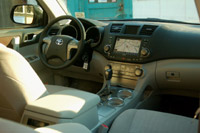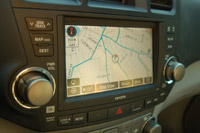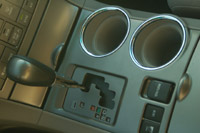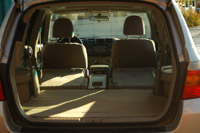2008 Toyota Highlander – Click above for high-res image gallery
The Highlander's undergone a nearly Kafka-esque transformation from its start as essentially a Camry wagon with all-wheel-drive and extra ride height. For 2008, Toyota's middle-child 'ute has been bulked up into more of a maxi-cruiser than previously. At first glance it appears what's emerged from the chrysalis is a grotesquely overinflated Forester, but the new Highlander is more butterfly than cockroach.
All photos ©2007 Dan Roth / Weblogs, Inc.
The styling does bear an uncanny resemblance to the Subaru Forester, but in person the scale of the 2008 Highlander separates it from Fuji's small CUV. The stance is far more purposeful than the previous Highlander, and there are plenty of little easter eggs hidden in the lines that will delight for months. One of the marks of good design is that it continues to surprise as it reveals itself over time, and living with the Highlander is punctuated by regular moments of "hey, look at that!"

The Highlander has been bulked up considerably, occupying a similar space as the 4-Runner. Measuring just an inch shorter than the 4-Runner (188.4 vs. 189.2 inches), the Highlander is just as wide and nearly as tall. As you'd expect, the unitized construction of the Highlander pays dividends once you move inside. All the measurements that equal passenger comfort; headroom, legroom, and hiproom are superior to the body-on-frame 4Runner. Only third row hiproom in the 4Runner is superior to the Highlander, which bests its truck-based stablemate significantly when it comes to accommodating the human form.


The Highlander is exceedingly well thought out for the way people use their vehicles. At every turn, the details have been considered and that's a joy for the end user. The interior is a big improvement over its predecessor, and the materials and design have taken a sizeable step forward. The four shower-sized knobs for the radio and ventilation system are wonderful in practice, and their damped motion feels expensive when you give one a twist. From where the driver sits, there's command over the three-zone HVAC system. The front seat passenger gets his own temperature knob, and folks in the rear also get their own climate controls, able to be engaged or disengaged by driver's master controls. The up-down button for the blower fan would have been better executed as a small knob, as would the mode switch to direct airflow.
Also marginally maddening is the integrated audio/navigation system. The menus are moderately Byzantine – it took three days to find the radio presets, for example – and the navigation system itself is only okay, in our opinion. The map display and operation isn't as easy as a Nissan or Ford nav, and loading or using the CD changer is confusing. You have to endure the self-animated LCD screen when adding or removing discs, and it's a bit of a fiddly routine to have to sit through just to get to the music.




While we didn't immediately love operating the entertainment system, that doesn't make it bad. The JBL speakers spread about the interior are augmented by a subwoofer, and it sounded great pounding out our favorite Little People songs while cruising around with the family. Families are definitely Toyota's bogey for the Highlander, and it's got the function and features to please. It starts with the little things, like the four cupholders in the front compartment, two with rubber inserts to secure smaller beverages, the light effort it takes to deploy or stow the third row, even the slick way the latch in the 2nd row's center position self-retracts with a hidden cable when you fold it down to an armrest. There's another alternate center armrest for the second row that hides away in its own drawer. The alternate offers cupholders and cubbies, a nice bit of versatility. There are remote levers in the cargo area that allow you to drop the 2nd row seats down with a light tug, too. The load floor is large and flat when you hide the seats, and the cargo area levers are a nice touch when you're loading 2x4s at the home center in a driving rain. Also nice in a deluge is the motorized hatch, which might be mistaken for supreme laziness until that time you've got your hands full of stuff. Convenience is the Highlander's strong suit.


The seats in all positions are comfortable, though the legroom drops off in stages as you move toward the back of the vehicle. The third row can accommodate adults, just not tall ones. The manageable (but still large) dimensions of the Highlander mean that you can either fill it up with people or stuff, but not both. The third row consumes the cargo area when in use. The retractable load cover and very nice carpeted mat also presented a challenge when using the third row. They're best left at home if you've got seven people to cart, but you don't always have advance warning when you're going to have to go into "mass transit" mode. We ended up rolling up the mat and wedging the cargo shade in (just barely) behind the hatch.
Even without a full frame and heavy-duty differentials underneath, the Highlander weighs about the same as the 4-Runner. Both vehicles are over 4,000 pounds; a four wheel drive Highlander Sport like we drove weighs in at 4,255 pounds, says Toyota. You feel that weight from behind the wheel. The overall feeling of the Highlander was very reminiscent of some full-frame vehicles we've driven. There's a vibratory sensation you get from behind the wheel – the steering column quivers a bit over bumps, for instance – that struck us as a tip of the hat to manly truckness, rather than any type of structural deficiency. Handling was good, though. Body roll is present, of course, but well reined in, and the ride is comfortable. Here's where that car-based platform pays dividends. The Highlander may be big and heavy, but it carries its avoirdupois differently than a truck-based hauler, leaving the end user with a vehicle that rides smoothly and can round corners at moderate velocities without requiring outriggers to stay upright.


There's plenty of power on tap, delivered in smooth fashion from the 2GR-FE 3.5 liter V6. The throttle can be twitchy when puttering around town or pulling away from stops, sometimes snapping everyone's head back when you just wanted to pull serenely out of the coffee shop parking lot. Mileage is also a bit trucky, high teens to low 20s is about all you can expect. The five-speed automatic is a smooth operator, although it's among the ranks of trannies that hate kicking down. It used to be that a little squeeze moved the kickdown cable enough to effect a snappy downshift, especially with the Aisin Warner units in Toyotas. No more. Modern-day electronically-controlled autos sometimes take an eternity to deliver what you've requested.
The steering is needle-bearing smooth, with a precision feel from lock to lock. There's not much information from the road surface making its way up to the wheel rim, but you don't miss it here. Highway slogs are a little busy when you're manning the Highlander's helm. The steering demands frequent small corrections, keeping the driver working harder than is necessary. Maybe a couple camber and toe tweaks in the front alignment would help, but we doubt that anyone's going to experiment. As far as gripes go, our complaint about the steering is relatively mild, and when you're surrounded by the rest of the goodness baked into the 2008 Highlander, it's easy to become an optimist.

The thing with the Highlander is that it's a great station wagon in the vein of the Wagon Queen Family Truckster. Nobody makes a full-size three-row wagon any more, and it's doubtful that one would sell very well, anyway. People still need a vehicle with space to haul bodies and boxes, so every manufacturer has whipped up a trucky-looking wagon-thing. Big wagon utility without the wood-paneled stigmata of yore has the crossover segment hotter than the core of a nuclear reactor. The popularity of the segment, plus Toyota's improvements to the Highlander figure to make it a popular buy in the high 20's to mid 30,000 dollar range.
All photos ©2007 Dan Roth / Weblogs, Inc.



Sign in to post
Please sign in to leave a comment.
Continue